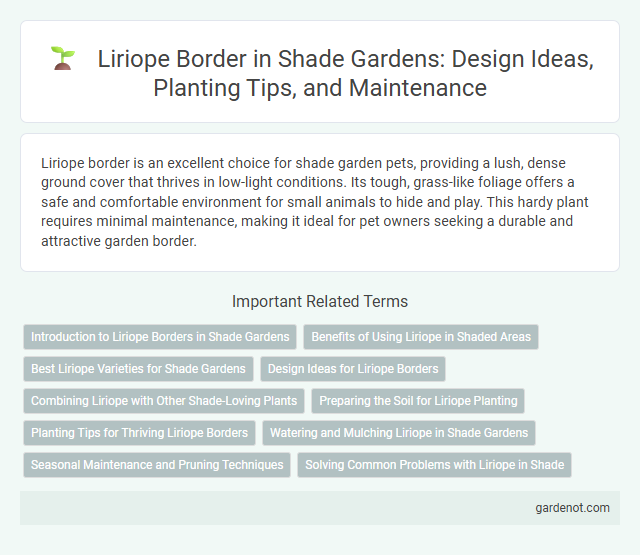Liriope border is an excellent choice for shade garden pets, providing a lush, dense ground cover that thrives in low-light conditions. Its tough, grass-like foliage offers a safe and comfortable environment for small animals to hide and play. This hardy plant requires minimal maintenance, making it ideal for pet owners seeking a durable and attractive garden border.
Introduction to Liriope Borders in Shade Gardens
Liriope borders thrive in shade gardens, offering dense, grass-like foliage that remains vibrant throughout the growing season. Known for their low maintenance and tolerance to low light, Liriope plants create natural borders that suppress weeds and enhance garden structure. Their small, purple flower spikes add subtle color contrast, supporting biodiversity by attracting pollinators in shaded environments.
Benefits of Using Liriope in Shaded Areas
Liriope borders thrive in shaded garden areas, providing dense ground cover that prevents soil erosion and suppresses weeds. Their evergreen foliage brightens dark spaces while requiring minimal maintenance, making them ideal for low-light environments. Liriope's resilience to varying moisture levels enhances landscape durability and supports biodiversity in shaded habitats.
Best Liriope Varieties for Shade Gardens
Liriope muscari 'Big Blue' offers dense, blue-green foliage and vibrant purple flowers, making it an excellent choice for shade gardens. The variety Liriope spicata 'Variegata' stands out with its variegated leaves that brighten darker garden areas while providing durable ground cover. For deeper shade, Liriope muscari 'Majestic' thrives with its large, lush leaves and abundant violet blooms, ensuring year-round visual interest in low-light conditions.
Design Ideas for Liriope Borders
Liriope borders transform shade gardens by providing deep green, grass-like foliage and vibrant purple flower spikes that contrast beautifully with dark soil or mulch. Design ideas include planting Liriope in clusters along curved paths or garden beds to create natural flow and texture, while combining with ferns and hostas for layered height and color variation. Integrating evergreen Liriope varieties ensures year-round structure and low-maintenance ground cover that suppresses weeds effectively.
Combining Liriope with Other Shade-Loving Plants
Liriope borders thrive in shaded garden areas and pair beautifully with hostas, ferns, and astilbes to create lush, textured layers. Combining Liriope with these shade-loving plants enhances both ground coverage and vertical interest, promoting a cohesive and vibrant under-canopy ecosystem. Their complementary foliage colors and growth habits ensure year-round visual appeal and improved garden biodiversity.
Preparing the Soil for Liriope Planting
Preparing the soil for Liriope planting in a shade garden requires well-drained, fertile soil with a slightly acidic to neutral pH between 6.0 and 7.0. Incorporate organic matter such as compost or aged manure to improve soil structure and moisture retention, promoting strong root development. Loosen the soil to a depth of at least 8-10 inches to ensure proper aeration and drainage for optimal Liriope growth.
Planting Tips for Thriving Liriope Borders
Liriope borders thrive in well-drained, humus-rich soil with consistent moisture but avoid waterlogging to prevent root rot. Plant liriope in partial to full shade, spacing individual plants 8 to 12 inches apart to allow for natural spreading and dense ground cover. Regular mulching preserves soil moisture and controls weeds, while occasional trimming of old foliage encourages fresh growth and maintains the border's aesthetic appeal.
Watering and Mulching Liriope in Shade Gardens
Liriope thrives in shade gardens with consistent watering that keeps the soil evenly moist but not waterlogged, ensuring healthy root development. Applying a 2-3 inch layer of organic mulch around the base helps retain soil moisture, regulate temperature, and suppress weeds, promoting vigorous growth. Regular mulching combined with proper watering reduces stress on Liriope during dry spells and supports its lush foliage in low-light conditions.
Seasonal Maintenance and Pruning Techniques
Liriope borders require seasonal maintenance that includes removing dead foliage in early spring to promote healthy new growth and improve air circulation. Pruning techniques involve cutting back the plant to about 2-3 inches above the soil level during late winter or early spring before new shoots emerge. Regular maintenance ensures vibrant foliage and prevents disease, maintaining the aesthetic appeal of shaded gardens.
Solving Common Problems with Liriope in Shade
Liriope thrives in shade but may experience issues like yellowing leaves due to poor drainage or excessive moisture. Ensuring well-drained soil and moderate watering prevents root rot and fungal diseases common in shaded areas. Regularly dividing overcrowded clumps promotes healthy growth and maintains a lush, green Liriope border in low-light conditions.
Liriope border Infographic

 gardenot.com
gardenot.com